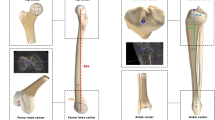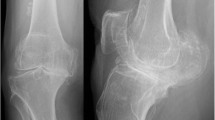Abstract
Introduction
This study asked whether differences in coronal alignment after total knee arthroplasty (TKA) affect the load distribution on the tibial plateau. The aim of this study was to investigate the correlation between coronal alignment and the load distribution on the tibial plateau after TKA, using three-dimensional multi-detector-row-computed tomography (3D-MDCT).
Materials and methods
In this study, we performed 84 cementless TKA with porous tantalum modular tibial component (PTMT) and divided into three groups based on post-operative hip–knee–ankle (HKA) angle: varus alignment group (n = 22), (176° ≧) neutral alignment group (n = 45), (180° ± 3°), and valgus alignment group (n = 17) (184° ≦).The changes in bone quality parameters of trabecular patterns under peg of PTMT were interpreted as load distribution due to changes in alignment. The relationship between HKA angle and load distribution on the tibial plateau was analyzed every 6 months for 4.5 years by measuring Bone marrow contents/tissue volumes (mg/cm3) and bone volumes/tissue volumes (%) under peg of porous tantalum modular tibial component by visualizing three dimensionally with 3D-osteo-morphometry software.
Results
There were no correlations between HKA angle and the load distribution on the tibial plateau after TKA at all periods. There was a significantly higher increase in the medial region than the lateral about the BMC/TV and BV/TV values, regardless of the post-operative alignment after TKA for all periods. The relative BMC/TV and BV/TV changes at medial region in varus alignment group were significantly lower than the neutral and the valgus alignment groups of pre-operative medial osteoarthritis of the knee.
Conclusions
As far, it can be concluded by the study and the methods used therein that there were no relationships between the load distribution on the tibial plateau and HKA angle after TKA.
Level of evidence
Therapeutic study, Level III.






Similar content being viewed by others
References
Lotke PA, Ecker ML (1997) Influence of positioning of prosthesis in total knee replacement. J Bone Jt Surg 59-A(1):77–79
Jeffery R, Merry R, Denham R (1991) Coronal alignment after TKR Bone. Jt Surg Br 73(B):709
Howell SM, Papadopoulos S, Kuznik KT, Hull ML (2013) Accurate alignment and high function after kinematically aligned TKA performed with generic instruments. Knee Surg Sports Traumatol Arthrosc 21:2271–2280
Fang DM, Ritter LA, Davis KE (2009) Coronal alignment in total knee arthroplasty: just how impotant is it? J Arthroplasty 24:39–43
Insall JN. Binazzi R, Soudry M, Mestriner LA (1985) Total knee arthroplasty. Clin Orthop Relat Res 92:3–22
Moreland JR (1988) Mechanisms of failure in total knee arthroplasty. Clin Orthop Relat Res 226:49–64
Ritter MA, Faris PM, Keating EM, Meding JB (1994) Postoperative alignment of total knee replacement: its effect on survival. Clin Orthop Relat Res 299:153–156
Tew M, Waugh W (1985) Tibiofemoral alignment and the results of knee replacements. J Bone Jt Surg Br 67:551–556
Bellemans J, Colyn W, Vandenneucker H, Victor J (2012) The Chitranjan Renawat award: is neutral mechanical alignment normal for all patients? The concept of constitutional varus. Clin Orthop Relat Res 470:45–53
Levine BR, Sporer S, Poggie RA, Della Valle CJ, Jacobs JJ (2006) Experimental and clinical performance of porous tantalum in orthopedic surgery. Biomaterials 27(27):4671–4681
Li MG, Nilsson KG (2000) Changes in bone mineral density at the proximal tibia after total knee arthroplasty. A 2-year follow-up of 28 knees using energy X-ray absorptiometry. J Orthop Res 18(1):40–47
Petersen MM, Nielsen PT, Lauritzen JB, Lund (1995) Changes in bone mineral density of the proximal tibia after un-cemented total knee arthroplasty. A 3-year follow-up of 25 knees. Acta Orthop Scand 66(6):513–516
Petersen MM, Gehrchen PM, Ostgaard SE, Nielsen PK, Lund B (2005) Effect of hydroxyapatite-coated tibia components on changes in bone mineral density of the proximal tibia after un-cemented total knee arthroplasty: a prospective randomized study using dual-energy X-ray absorptiometry. J Arthroplasty 20(4):516–520
Wang CJ, Wang JW, Ko JY, Weng LH, Huang CC (2006) Three-year changes in bone mineral density around the knee after a six-month course of oral alendronate following total knee arthroplasty. A prospective randomized study. J Bone Jt Surg Am 88(2):267–272
Wang CJ, Wang JW, Weng LH, Hsu CC, Huang CC, Chen HS (2003) The effect of alendronate on bone mineral density in the part of the femur and proximal part of the tibia after total knee arthroplasty. J Bone Jt Surg Am 85(11):2121–2126
Au AG, James RV, Liggins AB, Amirfazil A (2007) Contribution of loading and material properties to stress shielding near the tibia component of total knee placements. J Biomech 40(6):1410–1416
Wolff J (1892) Das Gaetz der Transformation, Transformation der Knochen. Hirschwald, Berlin
Noyama Y, Nakano T, Ishimoto T, Sakai T, Yoshikawa H (2013) Design and optimization of the oriented groove on the hip implant surface to promote bone microstructure integrity. Bone 52:659–667
Victor J, Bellemans J (2006) Physiologic kinematics as a concept for better flexion in TKA. Clini Orthop Relat Res 452:53–58
D’ Lima DD, Patil S, Steklov N, Colwell CW Jr (2011) The 2011 ABJS Nicolas Andry Award: ‘Lab’-in-a-knee: in vivo knee forces, kinematics, and contact analysis. Clini Orthop Relat Res 469(10):2953–2970
Colwell CW Jr, Chen PC, D’Lima DD (2011) Extensor malalignment arising from femoral component malrotation in knee arthroplasty: effect of rotating-bearing. Clin Biomech 26(1):52–57
Mizu-uchi H, Colwell CW Jr, Matsuda S, Flores-Hernandez C, Iwamoto Y, D’Lima DD (2011) Effect of total knee arthroplasty implant position on flexion angle before implant-bone impingement (2011). J Arthroplasty 26(5):721–727
Kuriyama S, Ishikawa M, Furu M, Ito H, Matsuda S (2014) Malrotated tibial component increases medial collateral ligament tension in total knee arthroplasty. J Orthop Res 32(2):1658–1666
Nakamura S, Tanaka Y, Kuriyama S, Nishitani K, Ito M, Furu M, Matsuda S (2017) Superior–inferior position of patella component affects patellofemoral kinematics and contact forces in computer simulation. Clin Biomech 45:19–24
Gustke KA, Golladay GJ, Roche MW, Elson LC, Anderson CR (2014) A new method for defining balance: promosing short-term clinical outcomes od sensor-guided TKA. J Arthroplasty 29(5):955–960
Gustke KA, Golladay GJ, Roche MW, Jerry GJ, Elson LC, Anderson CR (2014) Increased satidfaction after total knee replacement using sensor-guided technology. Bone Joint J 96-B(10):1333–1338
Nodzo SR, Franceschini V, Gonzalez Della Valle A (2017) Intraoperative load-sensing variability during cemented, posterior-stabilized total knee arthroplasty. J Arthroplasty 32(1):66–70
Manning WA, Ghosh K, Blain A, Longstaff L, Deehan DJ (2017) Tibiofemoral forces for the native and post-arthroplasty knee: relationship to maximal laxity through a functional arc of motion. Knee Surg Sports Traumatol Arthrosc 25(6):1669–1677
Insall J, Dorr LD, Scott RD, Scott WN (1989) Rationale of the Knee Soiety clinical rating system. Clini Orthop Relat Res 248:13–14
Cooke TDV, Sled EA, Scudamore RA (2007) Frontal plane knee alignment: a call standardized measurement. J Reumatol 34(9):1796–1801
Ito M, Ikeda K, Nishiguchi M, Uetani M, Hosoi T, Orimo H (2005) Multi-detector row imaging of vertebral microstructure for evaluation of fracture risk. J Bone Miner Res 20(10):1828–1836
Kaneko T, Otani T, Kono N, Mochizuki Y, Mori T, Nango N, Ikegami H, Musha Y (2016) Weekly injection of teriparatide for bone ingrowth after cementless total knee arthroplasty. J Ortho Surgery 2481:16–21
Inoue K, Hamano T, Nango N, Matsui I, Tomida K, Mikami S, Fujii N, Nakano C, Obi Y, Shimomura A, Kasunoki Y, Rakugi H, Isaka Y, Tsubakihara Y (2014) Mulitidetector-row computed tomography is useful to evaluate the therapeutiv effects of bisphosphonates in glucocorticoid-induced osteoporposis. J Bone Miner Metab 32(3):271–280
Okazaki N, Chiba K, Taguchi K, Nango N, Kubota S, Ito M, Osaki M (2014) Trabecular microfractures in the femoral head with osteoporosis: analysis of microcallus formations by synchrotron radiation micro CT. Bone 64:82–87
Iwamoto J, Seki A, Nango N (2016) Influence of teriparatide and ibandronate on cortical bone in New Zealand white rabbits: a HR-QCT Study. Calci Tissue Int 99(5):535–542
Ito M (2011) Recent progress in bone imaging for osteoporosis research.J Bone Miner Metab 29(2):131–140
Wang J, Ishimoto T, Nakano T (2017) Unloading-induced degradation of the anisotropic arrangement of collagen/apatite in rat femurs. Carcified Tissue Int 100:87–94
Kuroshima S, Nakano T, Ishimoto T, Sasaki M, Inoue M, Yasutake M, Sawae T (2017) Optimally oriented grooves on dental implants improve bone quality around implants under repetitive mechanical loading. Acta Biomater 48:433–444
Yamamura K, Minoda Y, Mizokawa S, Ohta Y, Sugama R, Nakamura S, Ueyama H, Nakamura H (2017) Novel alignment measurement technique for total knee arthroplasty using patient specific instrumentation. Arch Orthop Trauma Surg 137(3):401–407
Hsu HP, Garg A, Waller PA, Spector M, Ewald FC (1989) Effect of knee component alignment on tibial load distribution with clnical correlation. Clin Orthop Relat Res 248:135–144
Matziolis G, Adam J, Perka C (2010) Varus alignment has no influence on clinical outcome in midterm follow-up after total knee replacement. Arch Orthop Trauma Surg 130(12):1487–1491
Paratte S, Pagnano MW, Trousdale RT, Berry DJ (2010) Effect of postoperative mechanical axis alignment on the fifteen-year survival of modern,cemented total knee replacements. J Bone Jt Surg Am 92(12):2143–2149
Magnussen RA, Weppe F, Demey G, Servien E, Lustig S (2011) Residual varus alignment does not compromise results of TKAs in patients with preoperative varus. Clini Orthop Relat Res 469(12):3443–3450
Vanlommel L. Vanlommel J, Claes S, Bellemans J (2013) Slight undercorrection following total knee arthroplasty results in superior clinical outcomes in varus knees. Knee Surg Sports Traumatol Artrosc 21(10):2325–2330
Thienpont E, Schwab PE, Cornu O, Bellemans J, Victor J (2017) Bone morphotypes of the varus and valgus knee. Arch Orthop Trauma Surg 137(3):393–400
Berend ME, Ritter MA, Meding JB, Faris PM, Keating EM, Redelman R, Faris GW, Davis KE (2004) Tibial component failure mechanisms in total knee arthroplasty. Clin Orthop Relat Res 428:26–34
D’ Lima DD, Chen PC, Colwell CW Jr (2001) Polyethylene contact stresses, articular congruity, and knee alignment. Clin Orthop Relat Res 392:232–238
Hangerford DS (1995) Alignment in total knee placements. AAOS Instr Lect 44:455–468
Lee BS, Lee SJ, Kim JM, Lee DH, Cha EJ, Bin SI (2011) No impact of severe varus deformity on clinical outcome after posterior stabilized total knee arthroplasty. Knee Surg Sports Traumatol Artrosc 9(6):960–966
Sarri T, Uvehammer J, Carlsson L, Regner L, Karrholm J (2007) Joint area constraint had no influence on bone loss in proximal tibia 5 years after total knee replacement. J Orthop Res 5(6):798–803
Eckstein F, Hudelmaier M, Cahue S, Marshall M, Sharma L (2009) Medial-to-Lateral ratio of tibiofemoral subchondral bone area is adapted to alignment and mechanical load. Calcif Tissue Int 84(3):186–194
Lee S, Lee BK, Lee SH, Park HG, Jun DS, Moon do H (2013) Effect of foot rotation on the mechanical axis and correlation between knee and whole leg radiographs. Knee Surg Sports Traumatol Arthrosc 22(3):630–635
Hirschmann MT, Konala P, Amsler F, Iranpour F, Friederich NF, Cobb JP (2011) The position and orientation of total knee replacement components: a comparison of conventional radiographs, transverse 2D-CT slices and 3D-CT reconstruction. J Bone Jt Surg Br 93(5):629–633
Acknowledgements
The authors thank Hiroaki Suzuki, Eriko Yamaguchi for their assistance in this study.
Funding
There is no funding source.
Author information
Authors and Affiliations
Corresponding author
Ethics declarations
Conflict of interest
The authors declare that they have no conflict of interest.
Ethical approval
This article does not contain any studies with human participants or animals performed by any of the authors.
Rights and permissions
About this article
Cite this article
Kaneko, T., Kono, N., Mochizuki, Y. et al. Is there a relationship between the load distribution on the tibial plateau and hip knee ankle angle after TKA?. Arch Orthop Trauma Surg 138, 543–552 (2018). https://doi.org/10.1007/s00402-018-2872-6
Received:
Published:
Issue Date:
DOI: https://doi.org/10.1007/s00402-018-2872-6




